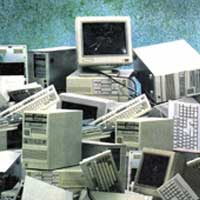
Like much of the world, Australia is engaged in a love affair with gadgets and other electronic items. As the technology and fashions change, these are frequently upgraded and replaced, and sales recently received an extra boost from the government’s stimulus package.
The downside to this picture is the issue of disposal. According to the Environment Protection and Heritage Council, a total of 16.8 million TV sets, computers and computer products were discarded during 2007-8, nearly one item per Australian. The arrival of digital TV will soon create a spike in the number of televisions being thrown out, and the switch to digital radio will require all analogue units to be replaced. In Australia, electronic waste (‘e-waste’) is growing about three times faster than the rest of the waste stream, and only about 9% of it is recycled.
Toxicity is the primary e-waste concern. Harmful chemicals includes lead (the solders in circuit boards), mercury (in switches), arsenic (cathode ray tubes) and brominated flame retardants (in plastics.) However, electronics also contain small quantities of valuable resources that can be recovered, include gold, silver, platinum, and palladium.
At present, {quotes} Australia is conspicuous for having no national e-waste strategy,{/quotes} and Griffith University waste management expert Sunil Herat believes that we are lagging behind other countries. In November, federal and state environment ministers will meet to hopefully decide on a national recycling program taking in both computers and TV sets. There is some optimism that this will kick off next July.
On the activist front, the Total Environment Centre and Environment Victoria have teamed up to create a campaign known as Reborn, which encourages people to email Peter Garrett and their state environment minister. One recent attention-grabbing action involved a group of human ‘toxic electronic waste zombies’ with computer monitors in place of heads who visited the Federal Minister’s Sydney office.
In the absence of federal action, South Australia has announced plans to introduce its own e-waste landfill ban, although no timeframe yet exists. Four councils along Sydney’s coastal strip will enforce similar bans next January, and they have been encouraging other councils to follow suit. This unilateral action puts added pressure on government authorities to come up with a solution soon.
Product stewardship is the term for take-back of items by manufacturers at the end of their life, either for re-use of parts or recycling. Government and industry estimates conclude that this would add a recycling fee of up to $10 per laptop computer and $35 per TV set. Research indicates that most consumers would be willing to pay such an additional levy.
Such a take-back plan enjoys the support of computer makers through the Australian Information Industry Association, and the electronics industry via Product Stewardship Australia (PSA.) In recent years, PSA has been vocal in calling for a national regulatory system.
Many examples of product stewardship exist overseas, including the EU, China, Japan, and a few US and Canadian states. Several Australian companies are set up to recycle e-waste, but the volumes handled are small in a market that has historically been dominated by ‘pay-to-recycle’ arrangements.
While waiting for a comprehensive national program to arrive, there are several steps that consumers can take to keep electronic items out of landfill. Although most of Australia’s e-waste is recycled responsibly, it is still worth asking where items that are dropped off will end up. In some developing countries, primitive recycling activities are harmful to both human health and the environment.
Unwanted mobile phones can be sold, given away on the Freecycle network, or otherwise recycled. The Mobile Muster recycling program has collection points in Australia Post outlets, Telstra, Optus and Vodaphone stores. Another option is the Mobile Phone Recycling program that involves freepost satchels.
Late model computer equipment is likely to find a buyer, and can alternatively be donated to a range of companies and charities listed on the Recycling Near You website.
For recycling, Dell offers free take-back of all its computers and peripheral equipment, and Toshiba provides a similar collection for its own-brand notebooks. Other e-waste collection services include Byteback operating in Victoria, and those offered by an increasing number of local councils. Further avenues include a range of companies that accept equipment (often for a fee), or to stockpile the equipment for a while longer as the range of collection points continues to expand.
Perhaps the greenest choices of all are to delay making a new purchase and to buy secondhand. When buying new electronic equipment, Greenpeace maintains a league table that ranks market leader companies according to their environmental performance, taking into account a range of factors including toxics, product stewardship policies and energy efficiency. The three top-ranked manufacturers, Nokia, Samsung and Sony Ericsson, all have voluntary take-back programs.
RESOURCES
Reborn campaign www.reborn.org.au
Product Stewardship Australia www.productstewardship.asn.au
Freecycle www.freecycle.org/group/AU
Mobile Muster www.mobilemuster.com.au
Mobile Phone Recycling www.mobilephonerecycling.com.au
Recycling Near You www.recyclingnearyou.com.au
Byteback program www.bytebackaustralia.com.au
Greenpeace electronics guide www.tinyurl.com/cc4j9







































